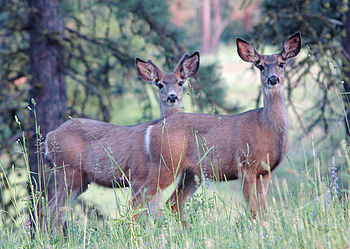
Significant natural gas development activity is occurring in Colorado. Currently there are more than 24,000 oil and natural gas wells in the State of Colorado. Increased levels of energy exploration and development on public lands, particularly for natural gas, have generated much concern over the welfare of wildlife populations that reside on these lands.
XTO Energy, a subsidiary of ExxonMobil agreed to donate $5 million to support research by Colorado State University and Colorado Parks and Wildlife (CPW) on improving wildlife and natural habitat in areas where natural gas activity is executed. The research will be conducted in the Piceance Creek Basin in Western Colorado, one of the largest natural gas reserves in the country, where the largest migratory mule deer population resides.
Founded in 1985 as Cross Timbers Oil Company, XTO Energy changed its name in 2001 and became a subsidiary of ExxonMobil in 2012. Based in Downtown Fort Worth, Texas, the energy producing company focuses primarily on oil and natural gas.
“ExxonMobil and XTO Energy are proud to be part of this unique collaborative effort,” said Romeo Perez, engineering manager, XTO Energy. “This partnership has been a great example of how private industry, academia and state agencies can work together to improve the compatibility of energy extraction with wildlife and habitat preservation.”
The studies are led by the Department of Fish, Wildlife, and Conservation Biology and Department of Forest and Rangeland Stewardship in CSU’s Warner College of Natural Resources and in collaboration with Colorado Parks and Wildlife.
The partnered research is on how adult female deer habitats are affected by natural gas development. Individual mule deer movement behaviors, habitat use and demography related to development activities will be examined. Understanding how energy development activities influence behavior of mule deer will help find and implement appropriate mitigation measures (e.g., timing restrictions, well density, surface occupancy), enhance mule deer management and inform future energy development planning.
Changes to the habitats these animals rely on are often obvious, such as the replacement of native vegetation with well pads, roads and pipelines. Added to these direct losses may be the subtle or indirect habitat losses caused by behavioral avoidance of areas in and around structures associated with development. The behavioral changes may result from increased levels of traffic, noise, pollution, or human activity. Due to human activity increases associated with the development, mule deer may be caused to be displaced or alter their habitat use patterns. Although it is relatively easy to quantify the direct habitat losses that result from the conversion of native vegetation to infrastructure, it is much more difficult to document indirect habitat losses.
The research will be talked about at the Colorado Chapter of The Wildlife Society’s 2014 Annual Winter Meeting from Feb. 5-7 at Hilton hotel, Fort Collins, CO. Its 350 members are educators, students, administrators, research scientists, consultants, resource managers, and wildlife law enforcement officers from all over Colorado. On Thursday, Feb 6, the afternoon session will focus on natural gas development and how it affects wildlife in Piceance Creek Basin. People who attend the conference are from the Wildlife Conservation Society, Colorado Parks and Wildlife, the Department of Fish, Wildlife, and Conservation Biology at CSU, and various universities and organizations around the United States.





